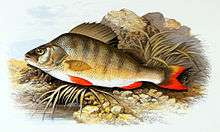European perch
| European perch | |
|---|---|
 | |
.jpg) | |
| Scientific classification | |
| Kingdom: | Animalia |
| Phylum: | Chordata |
| Class: | Actinopterygii |
| Order: | Perciformes |
| Family: | Percidae |
| Genus: | Perca |
| Species: | P. fluviatilis |
| Binomial name | |
| Perca fluviatilis Linnaeus, 1758 | |
 | |
| Red = native range Green = introduced range | |

Perca fluviatilis, commonly known as the European perch, perch, redfin perch, Big-scaled redfin, English perch, Eurasian perch, Eurasian river perch or common perch, is a predatory species of perch found in Europe and northern Asia. The species is a popular quarry for anglers, and has been widely introduced beyond its native area, into Australia, New Zealand, and South Africa. They have caused substantial damage to native fish populations in Australia and have been proclaimed a noxious species in New South Wales.[1]
Description
European perch are greenish with red pelvic, anal and caudal fins. They have five to nine dark vertical bars on their sides.
European perch can vary greatly in size between bodies of water. They can live for up to 22 years, and older perch are often much larger than average; the maximum recorded length is 60 cm (24 in). The British record is 2.8 kg (6 lb 2 oz), but they grow larger in mainland Europe than in Britain. As of May 2016, the official all tackle world record recognised by the International Game Fish Association stands at 2.9 kg (6 lb 6 oz) for a Finnish fish caught September 4, 2010.[2] In January 2010 a perch with a weight of 3.75 kg (8 lb 4 oz) has been caught in the River Meuse, Netherlands.[3] Due to the low salinity levels of the Baltic Sea, especially around the Finnish archipelago and Bothnian Sea, many freshwater fish live and thrive there. Perch especially are in abundance and grow to a considerable size due to the diet of Baltic herring.
Distribution and habitat
The range of the European perch covers fresh water basins all over Europe, excluding the Iberian peninsula. Their range is known to reach the Kolyma River in Siberia to the east.[4] It is also common in some of the brackish waters of the Baltic Sea.[5]
European perch has been widely introduced, with reported adverse ecological impact after introduction.[4]
The European perch lives in slow-flowing rivers, deep lakes and ponds. It tends to avoid cold or fast-flowing waters but some specimens penetrate waters of these type, although they do not breed in this habitat.[5]
Behaviour and reproduction
Perch is predatory species, juveniles feed on zooplankton, bottom invertebrate fauna and other perch fry while adults feed on both invertebrates and fish, mainly stickle-backs, perch, roach and minnows.[5]
The perch spawns (in the Northern Hemisphere) between February and July,[5] depositing the eggs upon water plants, or the branches of trees or shrubs that have become immersed in the water.[4] The eggs have been known to stick to the legs of wading birds and then transferred to other waters where the birds visit.
Taxonomy
The first scientific description of the river perch was made by Peter Artedi in 1730. He defined the basic morphological signs of this species after studying perch from Swedish lakes. Artedi described its features, counting the fin rays scales and vertebrae of the typical perch.
In 1758, Carl Linnaeus named it Perca fluviatilis.[6] His description was based on Artedi's research.
Fishing
European perch is fished for food and game fishing.[5]
According to FAO statistics 28 920 tonnes were caught in 2013. Largest perch fishing countries were Russia, (15 242 tonnes), Finland (7 666 tonnes), Estonia (2 144 t), Poland (1 121 t) and Kazakhstan (1 103 t).[5]
Baits for perch include minnows, goldfish, weather loaches, pieces of raw squid or pieces of raw fish (mackerel, bluey, jack mackerel, sardine), or brandling, red, marsh, and lob worms, maggots, shrimp (Caridina, Neocaridina, Palaemon, Macrobrachium) and peeled crayfish tails. The tackle needed is fine but strong. Artificial lures are also effective, particularly for medium-sized perch.
Relation to the yellow perch
Because of their similar appearance and ability to cross-breed, the yellow perch (Perca flavescens) has sometimes been classified as a subspecies of the European perch, in which case its trinomial name would be Perca fluviatilis flavescens.
Diseases and parasites
Cucullanus elegans is a species of parasitic nematodes. It is an endoparasite of the European perch.
References
- ↑ http://www.dpi.nsw.gov.au/fisheries/pests-diseases/freshwater-pests/species/redfin-perch
- ↑ "Official World Record".
- ↑ http://www.fisch-hitparade.de/fischhitparade/fang_anzeigen.php?fid=9854
- 1 2 3 "Perca fluviatilis Linnaeus, 1758". FishBase. Retrieved 2015-10-17.
- 1 2 3 4 5 6 "Species Fact Sheet (incl. link to FishStat)". FAO. Retrieved 17 October 2015.
- ↑ "Synonyms of Perca fluviatilis Linnaeus, 1758". FishBase. Retrieved 2009-11-23.
External links
| Wikimedia Commons has media related to Perca fluviatilis. |
- J. Freyhof & M. Kottelat (2008). "Perca fluviatilis". IUCN Red List of Threatened Species. Version 2011.2. International Union for Conservation of Nature. Retrieved January 4, 2012.
- "Perca fluviatilis". Integrated Taxonomic Information System. Retrieved 6 June 2006.
- Fishbase.org - European perch
- Redfin Perch – Perca fluviatilis
